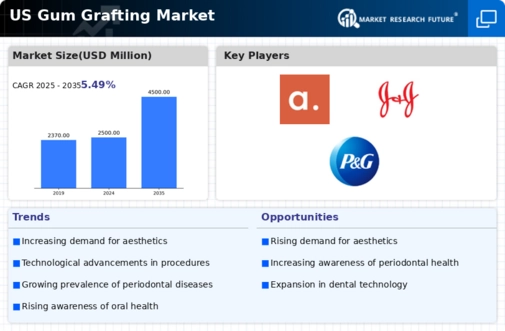Rising Geriatric Population
The demographic shift towards an aging population in the US is poised to positively impact the market for gum grafting. By 2030, it is projected that 20% of the US population will be aged 65 and older. This age group is particularly susceptible to oral health issues, including gum recession and periodontal disease, which often necessitate gum grafting procedures. As older adults seek to maintain their oral health and quality of life, the demand for gum grafting is likely to increase. Additionally, the financial capacity of this demographic, often supported by retirement savings or insurance, may facilitate access to these procedures. Consequently, the growing geriatric population serves as a significant driver for the gum grafting market, as dental practitioners adapt their services to meet the needs of this expanding patient base.
Advancements in Dental Technology
Technological innovations in dental procedures are transforming the gum grafting market. The introduction of minimally invasive techniques, such as laser-assisted gum grafting, has enhanced patient outcomes and reduced recovery times. These advancements not only improve the efficacy of the procedures but also increase patient comfort, leading to higher acceptance rates. Moreover, the integration of digital imaging and 3D printing in treatment planning allows for more precise graft placements, which can result in better aesthetic outcomes. As dental professionals adopt these cutting-edge technologies, the gum grafting market is likely to experience growth, driven by both improved patient satisfaction and the potential for increased procedural efficiency. The ongoing investment in research and development within the dental sector further indicates a promising future for the gum grafting market.
Increasing Prevalence of Gum Disease
The rising incidence of gum disease in the US is a primary driver for the gum grafting market. Studies indicate that nearly 47% of adults aged 30 and older exhibit some form of periodontal disease. This alarming statistic underscores the necessity for effective treatment options, including gum grafting procedures. As awareness of the consequences of untreated gum disease grows, patients are more likely to seek surgical interventions. The gum grafting market is expected to benefit from this trend, as dental professionals increasingly recommend grafting to restore gum health and aesthetics. Furthermore, the financial implications of untreated gum disease, which can lead to tooth loss and costly dental procedures, may motivate patients to invest in preventive measures like gum grafting. Thus, the increasing prevalence of gum disease significantly propels the demand for gum grafting services in the US.
Growing Focus on Preventive Dental Care
The shift towards preventive dental care in the US is influencing the gum grafting market. Patients are increasingly prioritizing oral health, leading to more regular dental check-ups and early interventions for gum issues. This proactive approach allows for the identification of gum recession and other periodontal problems before they escalate, often resulting in the recommendation of gum grafting as a preventive measure. Additionally, dental insurance plans are beginning to cover more preventive services, making gum grafting more accessible to a broader patient base. As awareness of the importance of maintaining healthy gums continues to rise, the gum grafting market is likely to see an uptick in demand, as patients seek to preserve their oral health and avoid more invasive treatments in the future.
Increased Marketing and Education Efforts
The gum grafting market is benefiting from enhanced marketing and educational initiatives by dental professionals and organizations. As practitioners emphasize the importance of gum health through various channels, including social media and community outreach, patients are becoming more informed about the benefits of gum grafting. Educational campaigns that highlight the risks associated with untreated gum recession and the advantages of grafting procedures are likely to drive patient inquiries and consultations. Furthermore, as dental practices invest in marketing strategies to promote their services, the visibility of gum grafting options increases, potentially leading to higher patient engagement. This focus on education and awareness is expected to contribute positively to the growth of the gum grafting market, as more individuals recognize the value of maintaining optimal gum health.














Leave a Comment